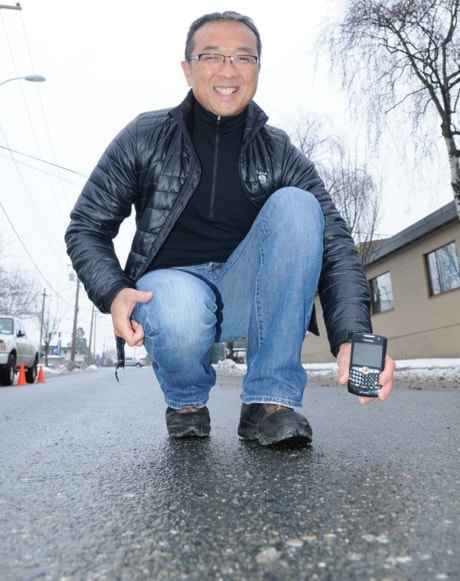There’s little predicting where in the city a wet road will transform into an icy one.
One day, James Bay will dip below zero while Oaklands sits at 1 C. The next day, the opposite pattern will occur. While neighbourhood roads may only vary by a couple of degrees, the distinction is critical. Knowing where and when to deploy a sanding or salting truck can turn a slippery road into a safe one.
In the past, Victoria’s public works department would rely on calls from drivers or road-condition assessments from city crews to better target their resources. Today, invisible sensors buried in the asphalt help inform city crews by providing temperature readings, in 10 locations around Victoria, 24-hours a day.
Gord Clark gets an alert sent to his Blackberry when one of these sensors detects a road-surface temperature of -0.5 C or colder. During a cold snap, such as the one last week, the acting supervisor of roads and bridges might get 50 to 60 alerts over the course of a night.
“I’ve had 15 hours of sleep in the last week,” said Clark, of his 18-hour work days keeping the roads as clear as possible.
Ironically, the sensors become irrelevant after a big dump of snow. In these rare events, every artery in the city becomes a high priority for ploughing. During a more typical cold snap, however, the sensors bring science into the equation.
“If I get more alerts from the Gonzales area, I’ll send the crews in there first,” Clark said.
The technology is formally known as Road Weather Information Systems, and often it monitors many conditions, including temperature, moisture, and other weather conditions. Airports use it to monitor runway conditions. By the year 2000 many highways and even some cities, such as Calgary and Kamloops, employed the technology.
By 2005, Transport Canada reported 150 roadside sensor sites had been installed by various jurisdictions in the country.
That’s when Victoria decided to jump on the bandwagon.
The problem, however, was that the systems available for purchase are propriety and “incredibly expensive,” said Deryk Lee, Victoria’s supervisor of water and underground utilities operations. Each monitoring site runs between $30,000 to $40,000, he added.
That’s why Victoria came out with its own in-house solution.
The city purchased 10 simple temperature sensors for $400 each. To make them communicate with the public works department, the sensors were wired into a different underground monitoring system already at work in the city.
“This was sort of an add on item to what we had already,” said Lee.
During the 1990s, the city installed sensors to monitor water pressure at 10 pump stations, or pressure-reducing valve stations, scattered throughout the municipality. The system, known as SCADA (Supervisory Control and Data Acquisition) communicates data by wireless modem in real time.
“We did a little cut into the asphalt, embedded (the temperature sensors) into the road, and then ran the wires back into the SCADA panel, and from there we would interpolate all the signals and send them back, and see them on the screen here (at the Public Works Yard),” said Lee.
Seven years have passed since road-temperature sensors were installed.
“They’re pretty much maintenance free,” said Clark.
The data, however, still requires judgement. For instance, a road can be very cold, but bone dry, he said.
The sensors are useful but will never replace employees physically testing the road conditions, said Clark.
“In my mind, that’s almost my best sensor.”
